Day 3 of a long weekend of tours today, and we headed the other way up to the eastern side of the North Norfolk coast. It was a slightly cloudy start to the day, but quickly brightened up to glorious winter sunshine.
We headed along the coast to Blakeney first and walked out along the seawall, with the Freshes on one side and the harbour on the other. There were lots of Brent Geese feeding along the edge of the harbour channel. A large flock of Linnets was whirling round, before dropping down onto the edge of the saltmarsh. A pair of Stonchats perched up on the top of the vegetation on the edge of the Freshes.
We stopped overlooking the harbour. The tide had gone out quickly, but we could still see a pair of Red-breasted Mergansers in the channel. Out on the mudflats were lots of waders – lots of Oystercatchers, Bar-tailed Godwits, Dunlins, Grey Plovers and Redshanks, plus a couple of Turnstones.
We had really come to look for the Lapland Buntings. There have been a handful here on and off since mid December, but they seem to roam over quite an area. There were a few people standing forlornly by the fence, but we walked on a little further to an area where we have seen them before. It was rather windy up on the seawall this morning, which made viewing difficult at times.
There were several Rock Pipits feeding around the wheel ruts through the mud. Then a group of Skylarks flew up from nearby, and in amongst them was at least one Lapland Bunting – unfortunately, they all promptly dropped down into the long grass. Then another group of Skylarks flew towards us from further along the path and we could see at least two more Lapland Buntings. They dropped down briefly in the open, but before we could get them in the scope, they took off again and disappeared into the long grass as well.
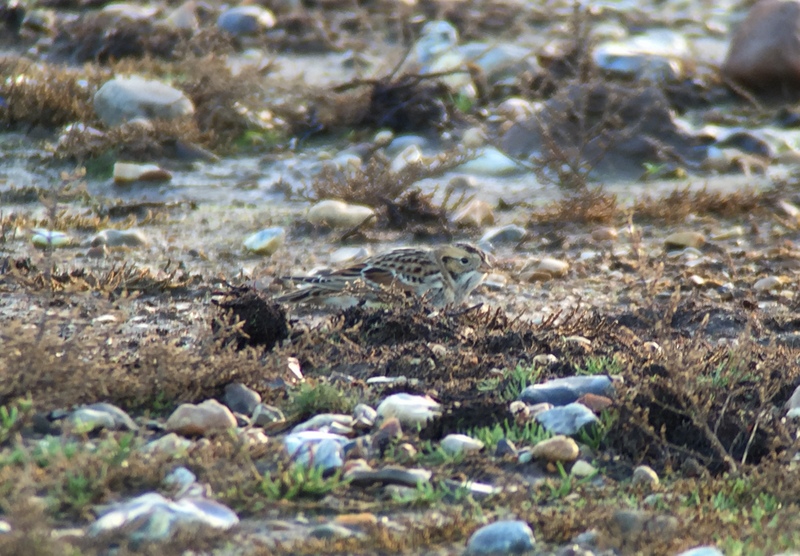 Lapland Bunting – taken at Blakeney a couple of weeks ago
Lapland Bunting – taken at Blakeney a couple of weeks ago
The same thing happened a couple more times – we got some good views of the Lapland Buntings in flight, but they would not settle in view. Then finally, a small group of Skylarks made their way out onto the edge of the mud, taking a single Lapland Bunting with them. We got a good look at it as it hopped about in and out of the wheel ruts. That seemed like a good moment to move on and try our luck elsewhere.
We made our way along to Cley and headed out along the East Bank. A Little Egret was feeding along a reedy channel by the new pools, having found somewhere out of the wind. A couple of Marsh Harriers were quartering over the reedbed. Several Reed Buntings were perched up in the bushes in the reeds. A single Black-tailed Godwit was hiding in the grass by the Serpentine, and on close examination it appeared to be sporting the first signs of summer plumage – some orange feathers on the breast and the start of the black belly bars.
 Black-tailed Godwit – starting to show a bit of orange on the breast
Black-tailed Godwit – starting to show a bit of orange on the breast
There were not as many ducks (or waders) as usual out on the grazing marshes beyond the Serpentine today – a couple of smallish groups of Wigeon and a pair of Gadwall. They had either moved elsewhere or something had possibly just flushed them all. As we walked further along the East Bank, more ducks started to fly back in. At first just a couple of Shoveler, but then a couple of waves of them.
Then the Pintail appeared as well, circling over the flooded Serpentine. We could see the long pin-shaped tail feathers of the drakes as they flew in. None of the ducks seemed to want to land, and most of the Pintail in the end dropped down over the back towards Arnold’s Marsh. Presumably something had spooked them.
 Pintail – circled over the Serpentine, but didn’t want to land again
Pintail – circled over the Serpentine, but didn’t want to land again
We got almost to the beach and turned right on the inside of the shingle ridge. We had really come to look for the Snow Buntings, which had been reported a couple of days ago here. However, they can wander quite widely up and down the beach, so it was by no means certain we would find them here. It seemed quite quiet as we walked along. There was only one other person in sight, and as we passed them they very helpfully told us exactly where the Snow Buntings were ahead of us. When we got there, sure enough there they were.
The Snow Buntings whirled round as we approached and dropped down out of view on the shingle. We carefully worked our way round and could see them shuffling around on the stones. We had a look at them through the scope, but then they took off again and whirled round once more. Rather than flying off, they landed even closer to us and we had a great view of them.
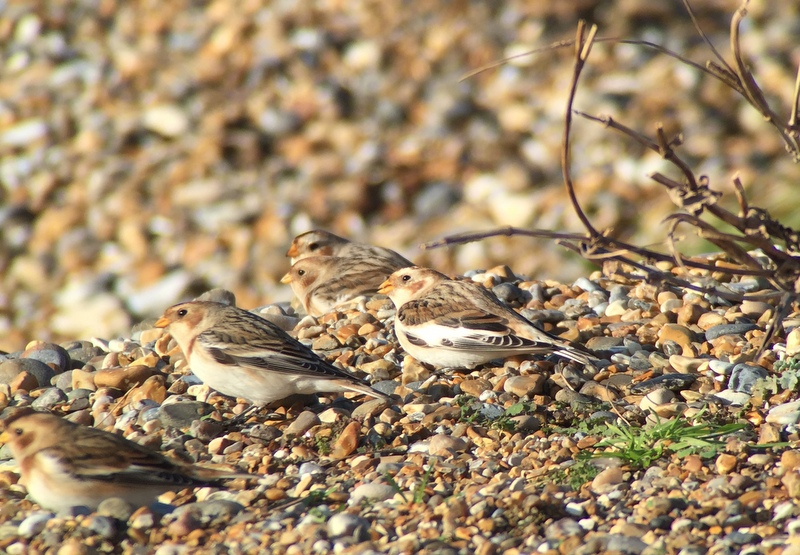
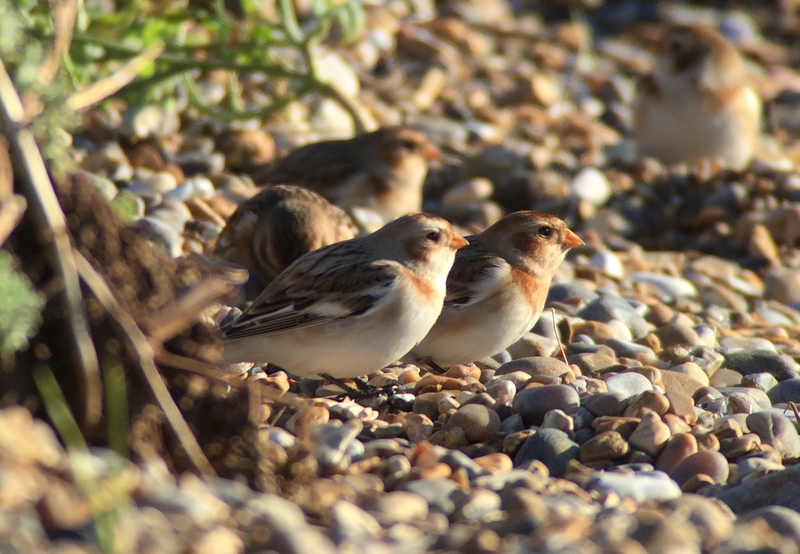
 Snow Bunting – around 30 today were along the beach at Cley
Snow Bunting – around 30 today were along the beach at Cley
There were around 30 Snow Buntings today. They were rather nervous and kept flying round, particularly when the Redshanks on Arnold’s Marsh started alarming. Each time, they landed again, sometimes closer, sometimes further over. It was great to watch them – and listen to their twittering calls. Then suddenly they took off again for no apparent reason and flew off back towards the East Bank.
We climbed up and dropped down onto the beach, into the lee of the remains of the shingle ridge. The sea looked quiet at first, but we spent a bit of time scanning and it yielded its rewards. We picked up several Red-throated Divers, their white faces in winter plumage really catching the sun. Then a Guillemot appeared, drifting west on the tide. Then we found a small group of Common Scoter diving just offshore – mostly females, but in amongst them was a single young drake.
The walk back was not without birds either – as well as all the things we had seen on the way out, just as we got back towards the car park we could hear a Bearded Tit calling. Unfortunately, it was rather too windy out here to look for Bearded Tits today, and we had to content ourselves with hearing one.
We could see a large flock of Brent Geese distantly in the Eye Field from the East Bank, as well as a line of Golden Plover shining in the sunlight. So we drove round there next for a closer look. We had just pulled up on Beach Road and started to scan through them when all the Golden Plover took off and made for the reserve. It took a few seconds for the Brent Geese to respond similarly, but the next thing we knew they were in the air too. Then we realised why – a Peregrine came shooting low over Beach Road and out across the Eye Field, before towering up and away beyond.
 Brent Goose – there were plenty in the Eye Field, before the Peregrine!
Brent Goose – there were plenty in the Eye Field, before the Peregrine!
We decided to break for lunch and sat in the sun in the beach shelter down at the car park. While we ate, a few of the Brent Geese started to drift back to the Eye Field and we could hear the growing throng over the traffic. Once we had finished, we walked up onto the West Bank for a closer look, but there were not the number of Brent Geese there had been and nothing of interest among the ones which had returned.
After lunch, we made our way further east still. On the way, our attention was drawn by a small group of dark looking geese in a grassy field at Salthouse. We pulled up briefly and could see they were nine White-fronted Geese. They looked quite smart in the sun and we could clearly see the black belly bars on the adults.
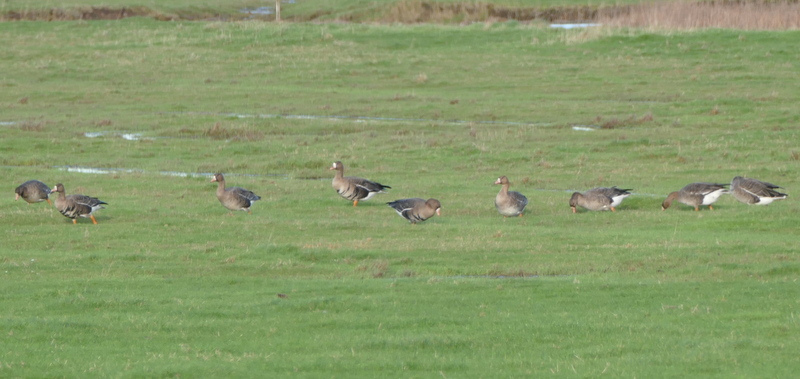 White-fronted Geese – nine were by the road at Salthouse this afternoon
White-fronted Geese – nine were by the road at Salthouse this afternoon
Our next destination was Weybourne. There has been a large flock of Redpolls in the weedy corner of a sugar beet field here in recent weeks – of two different species, at least as far as current Redpoll taxonomics defines them. We found them pretty quickly, but they were very flighty, constantly dropping down into the tall weedy growth to feed, before flying up again to land on the overhead wires or into the trees. While we were waiting to get better views of them, we had to content ourselves with a couple of Bramblings amongst the Chaffinches.
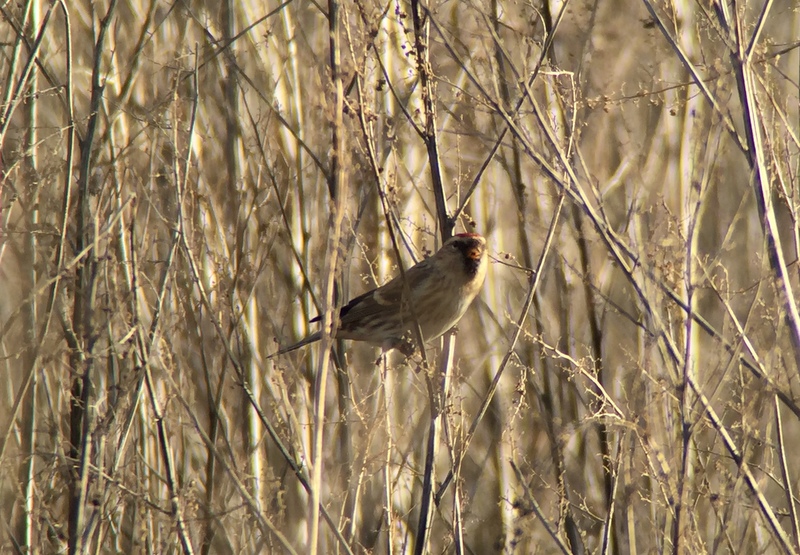 Lesser Redpoll – feeding in the weedy field at Weybourne
Lesser Redpoll – feeding in the weedy field at Weybourne
Most of them appeared to be Lesser Redpolls, but the more we looked the more we started to see the odd one or two which looked different – paler faced, more frosty looking. One or two of these at least looked good for Mealy Redpolls, but it was very hard to nail most of them for sure, as they just wouldn’t sit still for more than a second. Finally, one remained behind in the trees, preening, so we could get the scope onto it. It had quite a paler face than the rather brown-fronted Lesser Redpolls, but what really set it apart was the rump – heavy black streaking against a very white background.
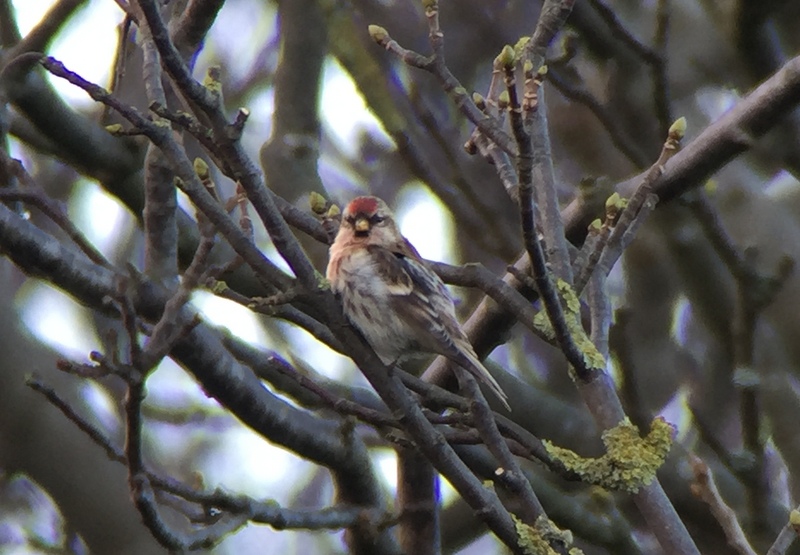 Mealy Redpoll – this one eventually perched up in the trees preening
Mealy Redpoll – this one eventually perched up in the trees preening
By the time we had secured good views of the Redpolls, it was time to be making our way back west. We wanted to finish the day at the harrier roost at Warham Greens – it was such a beautiful evening for it, especially now the wind had dropped. We parked up at the start of the track and walked down. There was a large flock of Linnets in a weedy field alongside and in amongst them we could see a few Yellowhammers when they all flew round.
It was all action from the second we arrived at the end of the track. A Merlin had just flown in and landed on one of the posts on the saltmarsh. We got it in the scope and had a good look at it – it then remained on its post for the rest of the evening! A ringtail Hen Harrier had just gone through and we picked it up over the marshes away to the east. Moments later, a second ringtail Hen Harrier appeared out to the west. Then a smart grey male Hen Harrier flew past and disappeared off towards Wells.
It was hard to tell exactly how many Hen Harriers there were this evening – at least two ringtails and one grey male, but possibly more. There were also at least three Merlins as well in the end – in addition to the one on its post, another was flying around the male Hen Harrier out to the west and a third flew in from behind us late on and landed on a bush.
There were also a few Barn Owls out hunting over the saltmarsh – at least two and possibly three. A closer one at first, not far out from the landward side but out to the west, then later two at the same time over the grass in front of East Hills. The Barn Owls were out hunting in good time, but unfortunately the same could not be said for the Short-eared Owl. It left it to the very last minute to appear and unfortunately was nigh on impossible for everyone to get onto it against the vegetation in the failing light, flying around low at the back of the saltmarsh.
We walked back up the track listening to Grey Partridges calling all around us. We even managed to get a few in the scope in the gathering gloom! It was a great way to end the weekend down at the roost. It had been another action packed few days with a great list of birds to show for it.
 Brent Geese – over the saltmarsh at Warham at dusk
Brent Geese – over the saltmarsh at Warham at dusk
















